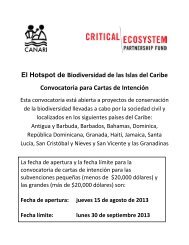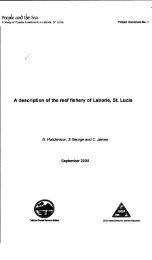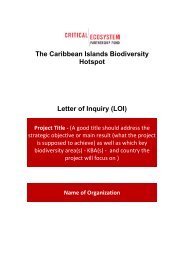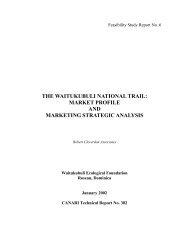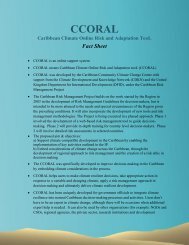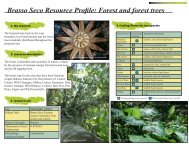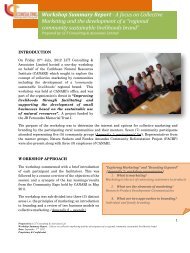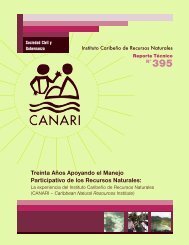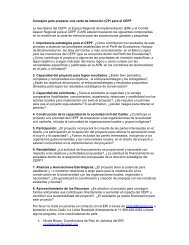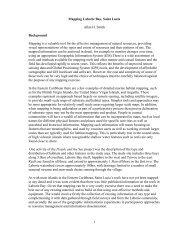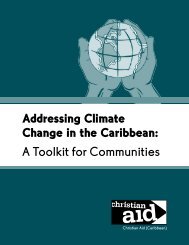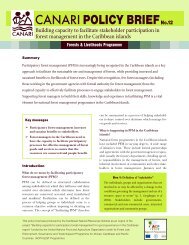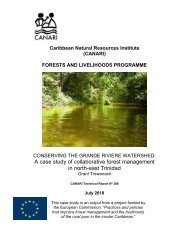Participatory Forest Management in the Caribbean - CANARI
Participatory Forest Management in the Caribbean - CANARI
Participatory Forest Management in the Caribbean - CANARI
Create successful ePaper yourself
Turn your PDF publications into a flip-book with our unique Google optimized e-Paper software.
<strong>CANARI</strong> Policy Brief<br />
No. 1 August 2002<br />
<strong>Participatory</strong> <strong>Forest</strong> <strong>Management</strong> <strong>in</strong> <strong>the</strong> <strong>Caribbean</strong>:<br />
Impacts and Potentials<br />
Mak<strong>in</strong>g better use of forest resources for equitable,<br />
susta<strong>in</strong>able development<br />
Throughout <strong>the</strong> world, forest management has been<br />
respond<strong>in</strong>g <strong>in</strong> recent years to demands for greater equity <strong>in</strong><br />
<strong>the</strong> distribution of forest resources and to <strong>the</strong> failure of<br />
traditional forestry approaches to achieve susta<strong>in</strong>able<br />
development objectives. Increas<strong>in</strong>gly, stakeholder<br />
participation, or participatory forest management, has<br />
become an important element of forest management<br />
strategies. <strong>Participatory</strong> forest management can be def<strong>in</strong>ed as<br />
structured collaboration between governments, commercial<br />
and non-commercial forest resource users, <strong>in</strong>terested<br />
organisations, community groups, and o<strong>the</strong>r stakeholders, to<br />
achieve shared objectives related to <strong>the</strong> susta<strong>in</strong>able use of<br />
forest resources.<br />
In <strong>the</strong> island countries of <strong>the</strong> <strong>Caribbean</strong>, forest resources<br />
tend to be limited <strong>in</strong> extent, largely accessible to <strong>the</strong> human<br />
population, and under constant pressure for conversion to<br />
o<strong>the</strong>r uses. In <strong>the</strong> absence of a strong surveillance and<br />
enforcement capacity, which none of <strong>the</strong> countries of <strong>the</strong><br />
region can f<strong>in</strong>ancially or politically afford, stakeholder<br />
participation provides <strong>the</strong> only avenue for effective<br />
management. It is also <strong>the</strong> most effective framework for<br />
address<strong>in</strong>g objectives of poverty alleviation, economic<br />
development and social equity <strong>in</strong> <strong>the</strong> management of natural<br />
resources.<br />
For <strong>the</strong>se reasons, many countries <strong>in</strong> <strong>the</strong> region have been<br />
revis<strong>in</strong>g forest legislation, policies, procedures, and<br />
management plans to <strong>in</strong>clude directives and strategies for<br />
stakeholder participation <strong>in</strong> decision-mak<strong>in</strong>g and<br />
management. Government forestry agencies have <strong>in</strong>creased<br />
<strong>the</strong>ir efforts to work with and through non-governmental<br />
partners, <strong>in</strong> some cases pushed along this path by<br />
<strong>in</strong>ternational assistance programmes. <strong>Forest</strong>ry adm<strong>in</strong>istration<br />
personnel have received considerable tra<strong>in</strong><strong>in</strong>g <strong>in</strong> fields<br />
related to participatory forest management. While <strong>the</strong>re has<br />
been real progress <strong>in</strong> some countries, too often <strong>the</strong>se<br />
changes are tak<strong>in</strong>g place without adequate <strong>in</strong>formation based<br />
on experience, and with<strong>in</strong> a broader context of cont<strong>in</strong>u<strong>in</strong>g<br />
centralised management, which limits <strong>the</strong>ir scope and<br />
potential effectiveness. This brief, which is based on a study<br />
conducted by <strong>the</strong> <strong>Caribbean</strong> Natural Resources Institute on<br />
<strong>the</strong> use of participatory forest management <strong>in</strong> ten countries<br />
of <strong>the</strong> <strong>in</strong>sular <strong>Caribbean</strong>, provides some guidance for <strong>the</strong><br />
fur<strong>the</strong>r development of participatory forest management <strong>in</strong><br />
<strong>the</strong> <strong>Caribbean</strong>.<br />
A look at participatory forest management <strong>in</strong> <strong>the</strong><br />
<strong>Caribbean</strong><br />
<strong>Forest</strong> management partnerships <strong>in</strong> <strong>the</strong> <strong>Caribbean</strong> <strong>in</strong>volve<br />
forest management agencies, NGOs, community groups,<br />
bus<strong>in</strong>esses, local resource users, and technical assistance<br />
organisations. The different stakeholders often play multiple<br />
roles, <strong>in</strong>clud<strong>in</strong>g mobiliser, partner, facilitator, regulator, and<br />
technical advisor. NGOs have been crucial <strong>in</strong> support<strong>in</strong>g <strong>the</strong><br />
participation of weaker community and resource user<br />
groups.<br />
The motivations of different stakeholders vary. <strong>Forest</strong>ry<br />
adm<strong>in</strong>istrations and o<strong>the</strong>r governmental stakeholders are<br />
usually <strong>in</strong>terested <strong>in</strong> <strong>in</strong>creas<strong>in</strong>g <strong>the</strong>ir management capacity by<br />
secur<strong>in</strong>g <strong>the</strong> help of o<strong>the</strong>r partners. Local resource users<br />
tend to be <strong>in</strong>terested <strong>in</strong> improv<strong>in</strong>g livelihoods, <strong>in</strong>come, and<br />
quality of life, while o<strong>the</strong>r civil society stakeholders may be<br />
motivated by concerns about equity and social justice. In<br />
enter<strong>in</strong>g <strong>in</strong>to partnerships, negotiation on objectives is often<br />
needed, result<strong>in</strong>g <strong>in</strong> projects that have both environmental<br />
and socio-economic dimensions and that require <strong>in</strong>put from<br />
a range of non-traditional actors, such as water resource<br />
management agencies, development NGOs, m<strong>in</strong>istries of<br />
community development, and tourism enterprises.<br />
This policy brief was produced by <strong>the</strong> <strong>Caribbean</strong> Natural Resources Institute (<strong>CANARI</strong>) with <strong>the</strong> support of <strong>the</strong><br />
John D. and Ca<strong>the</strong>r<strong>in</strong>e T. MacArthur Foundation. It is based on a study prepared by <strong>CANARI</strong> <strong>in</strong> 2002,<br />
entitled <strong>Participatory</strong> forest management <strong>in</strong> <strong>the</strong> <strong>in</strong>sular <strong>Caribbean</strong>: current status and progress to date, which<br />
was produced through a European Commission-funded project, “Build<strong>in</strong>g Capacity for <strong>Participatory</strong> <strong>Forest</strong><br />
<strong>Management</strong> <strong>in</strong> <strong>the</strong> <strong>Caribbean</strong>” (F<strong>in</strong>anc<strong>in</strong>g Agreement B7-6201/98/11/VIII/FOR). The views and op<strong>in</strong>ions<br />
expressed are those of <strong>CANARI</strong> alone.
<strong>Participatory</strong> forest management embraces many types of partnerships and arrangements. In <strong>the</strong> <strong>Caribbean</strong>, <strong>the</strong> follow<strong>in</strong>g types<br />
are <strong>the</strong> most common:<br />
Type of arrangement<br />
Contractor/contractee<br />
relationship<br />
Loose collaboration<br />
Formal collaboration<br />
Multi-stakeholder<br />
management or advisory<br />
bodies<br />
Characteristics<br />
•Objectives and outputs def<strong>in</strong>ed by <strong>the</strong> contract<strong>in</strong>g party<br />
•The arrangement only def<strong>in</strong>es <strong>the</strong> rights and responsibilities of parties to contract, not o<strong>the</strong>rs who may<br />
affect or be affected by management<br />
•Objectives generally def<strong>in</strong>ed by <strong>in</strong>itiat<strong>in</strong>g party; entry open to o<strong>the</strong>rs based on <strong>in</strong>terest<br />
•Parties not bound by a formal agreement<br />
•Objectives def<strong>in</strong>ed jo<strong>in</strong>tly by parties to agreement<br />
•Roles, responsibilities, rights and benefits clearly spelled out and to some extent b<strong>in</strong>d<strong>in</strong>g<br />
•Important stakeholders may be left out, affect<strong>in</strong>g <strong>the</strong> potential for achiev<strong>in</strong>g management objectives<br />
•Objectives def<strong>in</strong>ed by multiple stakeholders<br />
•May not result <strong>in</strong> actual reallocation of responsibility but function only at an advisory level<br />
•May <strong>in</strong>fluence or def<strong>in</strong>e policy<br />
•Benefits to participants least direct; ma<strong>in</strong>ta<strong>in</strong><strong>in</strong>g <strong>in</strong>terest can be a challenge<br />
Keys to last<strong>in</strong>g partnerships<br />
Some examples of long-stand<strong>in</strong>g PFM arrangements are described <strong>in</strong> <strong>the</strong> boxes below. These and o<strong>the</strong>r endur<strong>in</strong>g stakeholder<br />
partnerships tend to have many of <strong>the</strong> follow<strong>in</strong>g characteristics:<br />
C National forest policy is generally favourable to stakeholder participation and provides some level of guidance for <strong>the</strong><br />
development of collaborative arrangements<br />
C At least one technically competent actor, whe<strong>the</strong>r a government agency, NGO, or <strong>in</strong>ternational assistance agency, takes <strong>the</strong><br />
lead to get <strong>the</strong> process started and ma<strong>in</strong>ta<strong>in</strong>s support until <strong>the</strong> arrangement is function<strong>in</strong>g effectively<br />
C The objectives of all parties are respected, even when <strong>the</strong>y differ, and are compatible with overall management objectives<br />
C The roles and responsibilities of all parties are clearly spelled out and fully meet management requirements<br />
C The rights of all parties <strong>in</strong> <strong>the</strong> arrangement are secured through a formal agreement, a policy directive or a management<br />
plan accepted by all<br />
C The benefits to all parties are perceived by <strong>the</strong> parties to be commensurate with <strong>the</strong>ir <strong>in</strong>vestments<br />
C Mechanisms for ongo<strong>in</strong>g dialogue and negotiation among <strong>the</strong> parties are effective and <strong>the</strong>ir rules are based on pr<strong>in</strong>ciples of<br />
mutual respect and equal rights.<br />
The Asa Wright Nature Centre: A Private Initiative to Manage Both Private and Public <strong>Forest</strong> Land<br />
The Asa Wright Nature Centre (AWNC), located <strong>in</strong> <strong>the</strong> forests<br />
of Tr<strong>in</strong>idad’s Nor<strong>the</strong>rn Range, was established under private<br />
ownership and management <strong>in</strong> 1967 for <strong>the</strong> purpose of<br />
protect<strong>in</strong>g forests through a strategy of ecotourism and land<br />
acquisition. Start<strong>in</strong>g with only 193 acres <strong>in</strong> 1967, <strong>the</strong> AWNC is<br />
now responsible for <strong>the</strong> management of 1000 acres of forest<br />
acquired through strategic land acquisition us<strong>in</strong>g returns from its<br />
successful ecotourism activities. This <strong>in</strong>cludes 250 acres of<br />
undemarcated forest reserve that Government has leased to <strong>the</strong><br />
Centre for 99 years <strong>in</strong> compensation for 36 acres of m<strong>in</strong>eral-rich<br />
land compulsorily acquired from AWNC <strong>in</strong> 1980.<br />
AWNC forest lands are managed through a mix of loose<br />
partnership arrangements and formal agreements. The Board of<br />
<strong>the</strong> AWNC comprises eighteen unpaid, voluntary members (10<br />
resident national and 8 non-resident <strong>in</strong>ternational) represent<strong>in</strong>g a<br />
range of development perspectives - from ecology to<br />
economics. National members constitute <strong>the</strong> Board of<br />
<strong>Management</strong> responsible for oversee<strong>in</strong>g <strong>the</strong> implementation of<br />
Board decisions by staff.<br />
Formal arrangements have been developed with surround<strong>in</strong>g<br />
communities to provide services to <strong>the</strong> AWNC. Village<br />
entrepreneurs provide transport and off-site tour-guide services,<br />
and <strong>the</strong>re is a cadre of on-site, tra<strong>in</strong>ed nature tour guides, who<br />
are from nearby communities, employed at <strong>the</strong> Centre. Local<br />
residents benefit directly as employees, suppliers of agricultural<br />
produce and o<strong>the</strong>r services or <strong>in</strong>directly through social support<br />
activities provided by <strong>the</strong> Centre, e.g. a managed playground <strong>in</strong><br />
<strong>the</strong> village, family health and vacation benefits to employees.<br />
Stakeholder conflicts are rare but when <strong>the</strong>y do arise, are<br />
managed effectively through <strong>in</strong>ternal facilitation strategies.<br />
Benefits to <strong>the</strong> environment have been watershed and wildlife<br />
protection and reduction <strong>in</strong> squatt<strong>in</strong>g. Revenues from <strong>the</strong><br />
Centre’s ecotourism enterprises are ploughed back <strong>in</strong>to its land<br />
acquisition and public education programmes.
Impacts of participatory forest management<br />
Much more research is needed to fully understand <strong>the</strong> impacts that participatory approaches have had and potentially could have<br />
on <strong>the</strong> management of forest resources <strong>in</strong> <strong>the</strong> <strong>Caribbean</strong>. But a review of exist<strong>in</strong>g cases gives evidence of some significant<br />
positive impacts, as well as unanticipated negative ones that may disproportionately affect poor or o<strong>the</strong>rwise marg<strong>in</strong>alized<br />
stakeholders. Some of <strong>the</strong> impacts that have been observed <strong>in</strong>clude:<br />
Type of Impact<br />
Ecological<br />
Economic<br />
Social<br />
Institutional<br />
Policy<br />
Observations<br />
• Resource degradation has been reversed and ecosystem health restored through stabilized use patterns and <strong>the</strong> control of overuse<br />
• Managed harvest<strong>in</strong>g of trees by resource users has resulted <strong>in</strong> more rapid regeneration<br />
• Livelihoods of persons who depend on forest resources have become more secure as a result of better managed forests (whose<br />
products<br />
can be sold at a higher price), <strong>in</strong>creased skills, and <strong>the</strong> exclusion of competitors<br />
• A few participatory arrangements have generated local employment<br />
• Livelihoods of those excluded from access to forest resources have become less secure, with fewer economic opportunities<br />
• Stakeholder groups that have become active partners <strong>in</strong> participatory arrangements have benefited from learn<strong>in</strong>g and <strong>in</strong>formation<br />
shar<strong>in</strong>g,<br />
<strong>in</strong>creas<strong>in</strong>g <strong>the</strong>ir management capacity and skills<br />
• <strong>Forest</strong> resource users who have been excluded from new management arrangements (and who often <strong>in</strong>clude <strong>the</strong> poor and<br />
powerless) may<br />
have been alienated and demotivated to protect forest resources<br />
•Changes <strong>in</strong> management arrangements have resulted <strong>in</strong> shifts <strong>in</strong> local power dynamics, produc<strong>in</strong>g new conflicts by favour<strong>in</strong>g some<br />
groups at <strong>the</strong> expense of o<strong>the</strong>rs<br />
• The culture, attitudes, and even structures of forest management agencies have become more focused on foster<strong>in</strong>g l<strong>in</strong>ks between<br />
forests and development<br />
• <strong>Management</strong> agreements between governments and o<strong>the</strong>r forest stakeholders are be<strong>in</strong>g used more frequently, but it has been<br />
difficult to move away from traditional structures and relationships<br />
• The <strong>in</strong>volvement of external agencies has had both positive and negative impacts, on <strong>the</strong> one hand support<strong>in</strong>g capacity-build<strong>in</strong>g,<br />
while on <strong>the</strong> o<strong>the</strong>r hand foster<strong>in</strong>g dependency on outside f<strong>in</strong>ancial and technical support<br />
• The use of participatory forest management experiences for advocacy by NGOs and regional organizations appears to have<br />
sensitised policy-makers on <strong>the</strong> usefulness of participatory approaches<br />
• Experience with stakeholder participation, even if not fully successful, moves policy <strong>in</strong> a direction more favourable to participation<br />
Bosque Seco: <strong>Forest</strong> Communities Mobiliz<strong>in</strong>g for <strong>Forest</strong> Protection and Economic Development<br />
The residents of <strong>the</strong> small community of Cabeza de Toro <strong>in</strong> <strong>the</strong><br />
southwest of <strong>the</strong> Dom<strong>in</strong>ican Republic have long relied on <strong>the</strong><br />
Bosque Seco (Dry <strong>Forest</strong>) for lumber, charcoal, and o<strong>the</strong>r goods<br />
that supplement <strong>the</strong>ir <strong>in</strong>come from small-scale agriculture. In<br />
1975, however, <strong>the</strong> community’s way of life was threatened when<br />
<strong>the</strong> government declared <strong>the</strong> area a “Charcoal Zone” and<br />
truckloads of outsiders began to clear-cut <strong>the</strong> forest for<br />
commercial charcoal and lumber. Well-connected landowners also<br />
took advantage of <strong>the</strong> situation by seek<strong>in</strong>g to grab title to state<br />
lands <strong>in</strong> <strong>the</strong> forest. For <strong>the</strong> residents of Cabeza de Toro, <strong>the</strong><br />
onslaught of outsiders resulted <strong>in</strong> <strong>the</strong> pollution of <strong>the</strong>ir water<br />
supply and loss of livestock, but also <strong>in</strong> <strong>in</strong>creased bus<strong>in</strong>ess for local<br />
shops, bars, and restaurants. Although <strong>in</strong>itially divided, <strong>the</strong><br />
community with <strong>the</strong> help of a local development organisation<br />
began to come toge<strong>the</strong>r around a strategy to protect <strong>the</strong><br />
resources of <strong>the</strong> forest <strong>in</strong> order to assure <strong>the</strong>ir own future<br />
livelihoods. Some of <strong>the</strong> components of <strong>the</strong> strategy <strong>in</strong>cluded:<br />
C <strong>the</strong> establishment of a Committee for <strong>the</strong> Protection of <strong>the</strong><br />
Dry <strong>Forest</strong>, which worked to sensitise <strong>the</strong> community on <strong>the</strong><br />
requirements for natural resource conservation<br />
C <strong>the</strong> formation of a team of voluntary forest wardens, who<br />
tra<strong>in</strong>ed timber harvesters and charcoal producers <strong>in</strong><br />
techniques to m<strong>in</strong>imise <strong>the</strong> negative impact on <strong>the</strong> forest<br />
C <strong>in</strong>itiation of dialogue with local and national government<br />
agencies to seek solutions to <strong>the</strong> problems caused by <strong>the</strong><br />
new policy<br />
These discussions resulted <strong>in</strong> an arrangement whereby <strong>the</strong><br />
community, through <strong>the</strong> Committee for <strong>the</strong> Protection of <strong>the</strong><br />
Dry <strong>Forest</strong>, selects <strong>the</strong> forest wardens, who receive a stipend<br />
from <strong>the</strong> government; controls <strong>the</strong> harvest<strong>in</strong>g of lumber <strong>in</strong> <strong>the</strong><br />
forest and has <strong>the</strong> right to seize and sell illegal lumber; and<br />
manages <strong>the</strong> transport of products from <strong>the</strong> forest, assur<strong>in</strong>g that<br />
all <strong>in</strong>come for that service rema<strong>in</strong>s <strong>in</strong> <strong>the</strong> community.<br />
The experience of Cabeza de Toro has motivated o<strong>the</strong>r<br />
communities <strong>in</strong> <strong>the</strong> Bosque Seco to organise. There are now<br />
thirty-one similar associations, which are united under <strong>the</strong><br />
Federation of Producers of <strong>the</strong> Bosque Seco, and which work <strong>in</strong><br />
close collaboration with <strong>the</strong> national forestry adm<strong>in</strong>istration. The<br />
government relies heavily on <strong>the</strong>se associations to assist <strong>in</strong> <strong>the</strong><br />
management of <strong>the</strong> forest and is pursu<strong>in</strong>g similar approaches <strong>in</strong><br />
o<strong>the</strong>r parts of <strong>the</strong> country.
“Our <strong>Forest</strong>, Our Policy, Our Future”: Grenada’s <strong>Participatory</strong> <strong>Forest</strong> Policy Process<br />
In Grenada, many of <strong>the</strong> problems affect<strong>in</strong>g forests, <strong>in</strong>clud<strong>in</strong>g<br />
deforestation, soil erosion and natural resource degradation,<br />
are simply a result of people struggl<strong>in</strong>g to obta<strong>in</strong> a livelihood.<br />
And because many of <strong>the</strong>se activities take place outside <strong>Forest</strong><br />
Reserves, <strong>the</strong> <strong>Forest</strong>ry Department had little control over<br />
<strong>the</strong>m. While <strong>Forest</strong>ry Department staff realized that forest<br />
management was not only about <strong>the</strong> production of timber <strong>in</strong><br />
Reserves, but also about multiple forest uses on both public<br />
and private lands, <strong>the</strong> national forest policy, prepared by<br />
external consultants, provided no guidance on work<strong>in</strong>g with<br />
forest stakeholders.<br />
As a result, <strong>in</strong> 1997 <strong>the</strong> Department embarked on <strong>the</strong><br />
development of a new forest policy that <strong>in</strong>volved all<br />
stakeholders and that looked beyond <strong>the</strong> management of <strong>the</strong><br />
<strong>Forest</strong> Reserves. The well-facilitated eighteen-month process,<br />
which was led by a <strong>Forest</strong> Policy Process Committee<br />
comprised of representatives of agencies and sectors with a<br />
major stake <strong>in</strong> forest management, <strong>in</strong>cluded <strong>the</strong> follow<strong>in</strong>g<br />
components:<br />
C sub-sector studies of forest policy issues such as watershed<br />
management, recreation, and wildlife conservation<br />
C adm<strong>in</strong>istration of questionnaires to a wide range of<br />
stakeholders and <strong>the</strong> general public<br />
C radio call-<strong>in</strong> programmes to seek public <strong>in</strong>put on forest<br />
management issues<br />
C consultation meet<strong>in</strong>gs with fourteen communities or<br />
stakeholder groups<br />
C a consensus-build<strong>in</strong>g workshop <strong>in</strong>volv<strong>in</strong>g over 180<br />
stakeholder representatives to develop a policy vision and<br />
objectives<br />
C a feedback workshop follow<strong>in</strong>g <strong>the</strong> draft<strong>in</strong>g of <strong>the</strong> policy to<br />
seek review and comments from stakeholders.<br />
The result<strong>in</strong>g policy, which was approved by Cab<strong>in</strong>et <strong>in</strong><br />
September 1998, addresses <strong>the</strong> country’s social, economic,<br />
and cultural needs and as such is owned by all Grenadians. But<br />
its implementation requires a restructur<strong>in</strong>g of <strong>the</strong> <strong>Forest</strong>ry<br />
Department so that it can effectively play <strong>the</strong> roles of facilitator,<br />
partner, and advocate. This difficult restructur<strong>in</strong>g process is<br />
now underway.<br />
How forest policies can support effective stakeholder participation<br />
<strong>Forest</strong> policies <strong>in</strong> <strong>the</strong> <strong>Caribbean</strong> region are becom<strong>in</strong>g more supportive of participatory approaches, but <strong>the</strong> overall policy<br />
framework still tends to favour centralised forms of management. Some measures that could make forest policies more<br />
effective <strong>in</strong>clude:<br />
• Greater stakeholder <strong>in</strong>volvement <strong>in</strong> policy formulation, with processes like <strong>the</strong> one used <strong>in</strong> Grenada (see above box)<br />
• Systems for cont<strong>in</strong>uous and participatory policy review<br />
• Policy support for capacity-build<strong>in</strong>g of management partners, and especially for non-governmental stakeholders<br />
• Policy guidance <strong>in</strong> support of benefits and <strong>in</strong>centives for participat<strong>in</strong>g stakeholders<br />
Policy should be <strong>in</strong>formed by solid research on <strong>the</strong> approaches and strategies that are most likely to achieve objectives of<br />
forest conservation and susta<strong>in</strong>ability. Some of <strong>the</strong> questions that research needs to address <strong>in</strong>clude:<br />
• What forms of tra<strong>in</strong><strong>in</strong>g and technical assistance are most effective <strong>in</strong> <strong>in</strong>creas<strong>in</strong>g <strong>the</strong> capacity of <strong>the</strong> different partners<br />
•<br />
•<br />
•<br />
How does participatory forest management affect different stakeholders through changes <strong>in</strong> power relations, development<br />
of new rules regard<strong>in</strong>g access to forest resources, <strong>the</strong> allocation of rights and benefits, and <strong>the</strong> imposition of new or<br />
changed responsibilities<br />
What are <strong>the</strong> characteristics of effective and equitable processes of negotiation among partners regard<strong>in</strong>g objectives,<br />
actions, and <strong>the</strong> allocation of rights, responsibilities, and rewards<br />
What are <strong>the</strong> characteristics of efficient and cost-effective systems for monitor<strong>in</strong>g effectiveness <strong>in</strong> meet<strong>in</strong>g ecological,<br />
economic, social, and <strong>in</strong>stitutional objectives<br />
• What are <strong>the</strong> costs and benefits of decentralised versus centralised management arrangements<br />
<strong>Caribbean</strong> Natural Resources Institute<br />
Fernandes Industrial Centre<br />
Adm<strong>in</strong>istration Build<strong>in</strong>g<br />
Eastern Ma<strong>in</strong> Road, Laventille<br />
Tr<strong>in</strong>idad and Tobago<br />
Telephone: 868 626-6062 • Fax: 868 626-1788<br />
Email: <strong>in</strong>fo@canari.org • Website: www.canari.org



